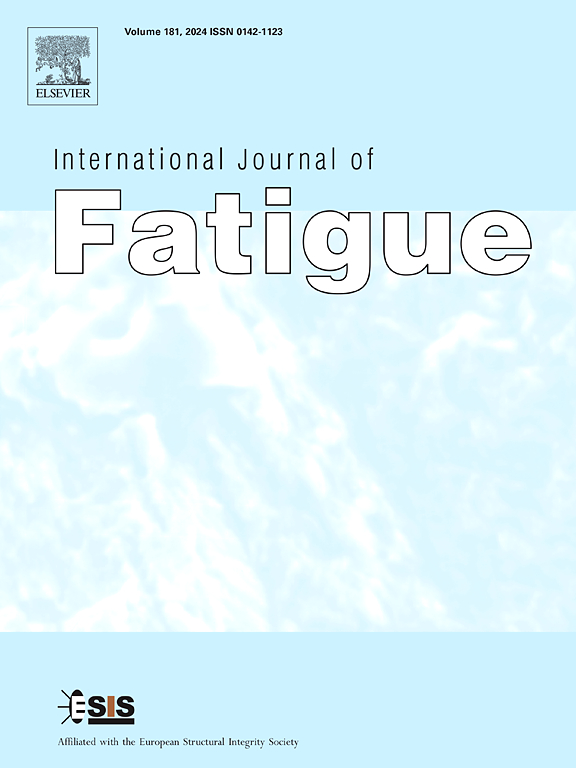Generalised notch stress method to evaluate the fatigue behaviour of rough and smooth wire arc additively manufactured components
IF 6.8
2区 材料科学
Q1 ENGINEERING, MECHANICAL
引用次数: 0
Abstract
The fatigue life of components under cyclic loading is highly sensitive to surface conditions, as imperfections lead to stress concentrations and early fatigue crack initiation. This study investigates the fatigue performance of both rough and smooth specimens made from S355 low-alloy carbon steel using a cold metal transfer (CMT)-based wire arc additive manufacturing (WAAM) process. Three types of specimens (machined, sinuous and raster specimens) with different surface geometries are fabricated. Rough fatigue coupons are cut using waterjet cutting from the as-deposited walls while keeping the rough surface unmachined. The geometric properties of rough fatigue coupons are quantified by a 3D laser scanner, followed by static tensile tests, hardness measurements and fatigue tests. Fatigue crack initiation and propagation for different surface types are analysed under scanning electron microscopy (SEM). Several computational methods, including the numerical local fatigue stress evaluation, the hot spot stress method and the effective notch stress method, are analysed for their effectiveness in assessing the fatigue resistance of rough specimens. A generalised notch stress method based on notch stress theory is proposed and validated. Our results prove that the fatigue performance of specimens with different surface conditions can be unified using the proposed generalised notch stress method.
用广义缺口应力法评价粗、光滑丝弧增材件的疲劳性能
构件在循环载荷下的疲劳寿命对表面条件非常敏感,因为缺陷会导致应力集中和早期疲劳裂纹萌生。本研究采用基于冷金属转移(CMT)的电弧增材制造(WAAM)工艺,研究了S355低合金碳钢的粗糙和光滑试样的疲劳性能。制作了三种不同表面几何形状的试样(机械、弯曲和光栅试样)。在保持粗糙表面未加工的情况下,使用水射流从沉积壁上切割粗糙的疲劳条。采用三维激光扫描仪对粗糙疲劳试样的几何特性进行了量化,然后进行了静态拉伸试验、硬度测试和疲劳试验。在扫描电镜下分析了不同表面类型的疲劳裂纹萌生和扩展过程。分析了数值局部疲劳应力评估法、热点应力法和有效缺口应力法等几种计算方法在粗糙试件疲劳抗力评估中的有效性。提出了一种基于缺口应力理论的广义缺口应力方法,并进行了验证。结果表明,采用广义缺口应力法可以统一不同表面条件下试样的疲劳性能。
本文章由计算机程序翻译,如有差异,请以英文原文为准。
求助全文
约1分钟内获得全文
求助全文
来源期刊

International Journal of Fatigue
工程技术-材料科学:综合
CiteScore
10.70
自引率
21.70%
发文量
619
审稿时长
58 days
期刊介绍:
Typical subjects discussed in International Journal of Fatigue address:
Novel fatigue testing and characterization methods (new kinds of fatigue tests, critical evaluation of existing methods, in situ measurement of fatigue degradation, non-contact field measurements)
Multiaxial fatigue and complex loading effects of materials and structures, exploring state-of-the-art concepts in degradation under cyclic loading
Fatigue in the very high cycle regime, including failure mode transitions from surface to subsurface, effects of surface treatment, processing, and loading conditions
Modeling (including degradation processes and related driving forces, multiscale/multi-resolution methods, computational hierarchical and concurrent methods for coupled component and material responses, novel methods for notch root analysis, fracture mechanics, damage mechanics, crack growth kinetics, life prediction and durability, and prediction of stochastic fatigue behavior reflecting microstructure and service conditions)
Models for early stages of fatigue crack formation and growth that explicitly consider microstructure and relevant materials science aspects
Understanding the influence or manufacturing and processing route on fatigue degradation, and embedding this understanding in more predictive schemes for mitigation and design against fatigue
Prognosis and damage state awareness (including sensors, monitoring, methodology, interactive control, accelerated methods, data interpretation)
Applications of technologies associated with fatigue and their implications for structural integrity and reliability. This includes issues related to design, operation and maintenance, i.e., life cycle engineering
Smart materials and structures that can sense and mitigate fatigue degradation
Fatigue of devices and structures at small scales, including effects of process route and surfaces/interfaces.
 求助内容:
求助内容: 应助结果提醒方式:
应助结果提醒方式:


